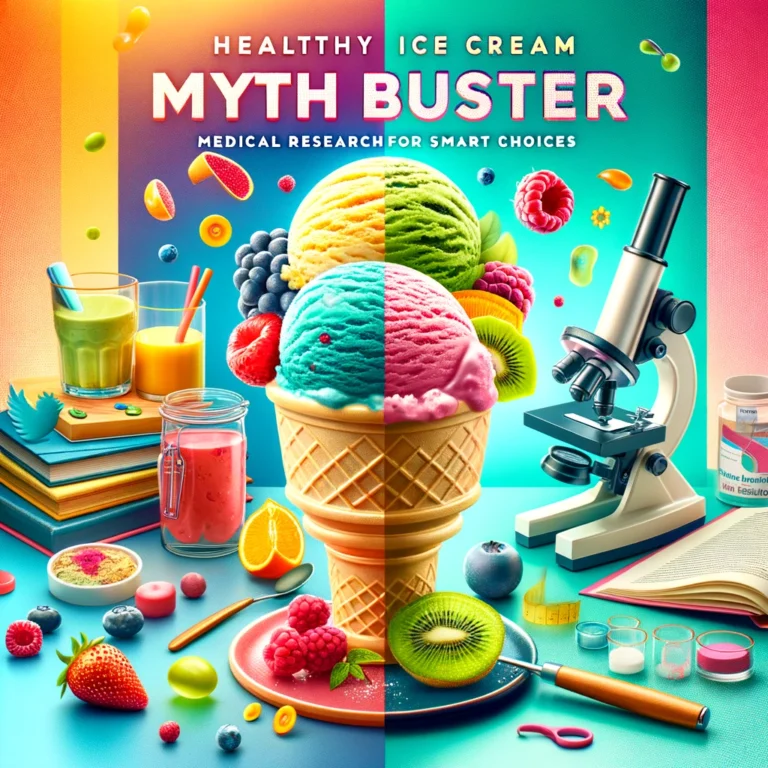
Recent Post

A constant pursuit in making desserts healthier always has ice cream at the top of the list, undergoing a “healthy” makeover. This is when shelves in the market today overflow with products that are labeled low-calorie, high-protein, sugar-free, or dairy-free, promising joy of indulgence without guilt. But do these truths get closer to reality? In this blog, we jump into popular myths surrounding healthy ice cream, armed with scientific evidence and medical research, to actually find out what makes a smarter choice for dessert cravings.
With such information, a consumer can put together the pieces of the health-marketing puzzle that ice cream sometimes is. It’s not just busting health myths but, rather, empowering informed, conscious choices that come from their personal health goal and dietary need alignment. The ultimate guide on how to make the best decisions regarding the frozen treats you choose, be it a fitness enthusiast, one having dietary restrictions, or just a lover of ice cream looking for healthier alternates.
The term “healthy” ice cream might actually be a misnomer because how nutritious it is depends largely on the ingredients used, their nutrient composition, and how they fit your overall diet. Typically, healthy ice creams try to reduce the amount of undesirable nutrients such as fats and sugars while increasing desirable ones such as proteins and fibers. Let’s take a closer look at what typically goes into these cold treats:
A good number of “healthy” ice creams use sugar substitutes such as stevia, erythritol, or monk fruit to cut down the sugar used. Although they may help reduce the number of sugars consumed, sugar substitutes likely raise as many long-term health issues as they resolve.
Some other replacements used include replacing heavy cream with whole milk, low-fat milk, or plant-based from the same source, or using synthetic fat replacers that change the texture and taste of food.
These are used to give the ice cream a desirable texture and taste, these have long raised fears of causing health problems. They include carrageenan, pectin, or locust bean gum.
Designed to have fewer calories per serving by decreasing sugars and fats.
Generally, low-fat ice cream is made using either reduced-fat milk or milk alternatives to low quantities of fat contributing significant calories in traditional ice creams.
These are targeted at fitness enthusiasts and thus their way to add protein content is through supplementation, often using whey or even plant-based proteins.
Made using almond, coconut, soy, or oat milk. Ideal option for people avoiding dairy products. These products don’t necessarily contain low calorie and sugars.
Keep in mind the above ingredient variations to know what passes as healthy ice cream and what complements your preference.
Misconceptions relate to the fact that “no added sugar” ice cream products contain 0 calories; people misunderstand that in them, only sugar provides the calorie content. In fact, even the number of calories is provided by all other macronutrients, including fats and proteins.
A majority of the sugar substitutes used in ice creams contain lesser caloric content than sugar but are not devoid of calories. For example, in erythritol, it has about 0.24 calories per gram, whereas sugar has 4 calories in that respective gram.
Some substitutes still show an effect on insulin responses or affect appetite in ways that may not be commensurate with his goal of weight loss.
Even though switching to no-added-sugar ice cream can cut calories, the deficit may not be as huge if high-calorie ingredients are used to make up for flavor and texture.
This is where the importance of careful reading of food nutritional labels comes to play; learning what the sum of the calories is and what comprises those calories, as not all calories are the same. The importance of their sources makes all the difference to health.
It is a common misconception that consuming healthy ice cream contributes directly to weight loss. Although the mentioned products have lower caloric values or are more nutrient-prolific compared to the traditional ice cream, there is a catch behind weight loss. Scientifical basis for ice cream and weight control.
Weight loss is reflecting burning more calories than consuming them. And even the healthy ice cream can make one gain weight if the overall amount of consumed calories will be larger than the number continued.
It was proven that the label of a healthy product makes people consume much more of it in accordance with the “halo effect”. People believe they are eating healthy when in turn might consumer more unhealthy calories.
Nutritional professionals emphasize the need for balance and moderation in everyday life in terms of consumption of all manufacturer products. A balanced diet is more sustainable and effective for weight management than relying on the ‘healthy’ labelling of the product.
It is a common perception that ice creams with the label of being dairy-free are considered to be healthier alternatives for regular ice cream for people with dairy allergies or lactose intolerance. Nonetheless, the label “dairy-free” does not automatically mean “healthier”.
Some non-dairy ice creams use high-calorie bases such as coconut milk or nuts, which potentially makes non-dairy count calories even higher than those of dairy-based counterparts. Calories should not be a major determinant of ice cream selection; however, this is a relevant consideration for frequent consumers.
Dairy ice cream has certain nutrients such as calcium and vitamin D, which are naturally present in such dairy products. It should be noted that many of the non-dairy options lack such nutrients, unless otherwise ensured. In summation, the health benefits of consuming any of the two depend on the formulation and additives contained in each brand.
Many people perceive high-protein ice creams as a potential substitute for a full meal since these products are marketed not only as a protein source but also as possible meal replacements. However, this claim requires verification.
Although high-protein ice creams contain a significantly higher amount of protein, they lack other essential nutrients that make up a balanced meal. This includes fiber, a variety of vitamins, and minerals
Meals are complex balances of macronutrients and micronutrients. Such an amazing balance contributes to satiety as well as energy. Ice creams, even though they are high in protein, do not provide the same level of nutritional balance and prolonged satiety.
Just because it is all-natural, it is healthy. The promise and expectation of natural components drive a vast number of purchases, as natural is often associated with healthier. Nevertheless, many ingredients labeled as natural are unhealthy or under exceptional conditions even dangerous. Ice cream is maybe the best example of it.
While natural ingredients like sugars and fats are essential for our body’s functions, they might not be fully used up by our metabolism. This means even all-natural products can contribute to weight gain if consumed in excess.
Not all “natural” ingredients are safe for everyone. Some can trigger allergic reactions, and others might cause problems depending on your health or diet. It’s important to be aware of any allergies or restrictions you have before consuming something natural.
Research on natural vs. synthetic ingredients shows surprising complexity. While synthetic additives might sound unappealing, they often undergo rigorous safety testing. Conversely, some natural ingredients with known health effects may not have been as thoroughly studied.
Eating smart is more than just looking out for keywords like low-fat or high-protein. It’s not enough to trust only on the claims scribed on a tub of ice cream. Forget “low-fat” or “high-protein” claims. Here are some practical tips for making right choices:
Don’t be fooled! Check the serving size before celebrating low calorie counts. A small serving adds up fast if you devour the whole pint.
Watch out for hidden sugars! Look beyond “added sugar” and check total carbs to see where those sugars are sneaking in. Not all sugars are added sugars, and many different ingredients can contribute to the sugar content in a product. Look at the Total Carbohydrate and Sugars line.
Pay attention to the fat type. Unsaturated fats are your friend, while saturated fats should be limited. Also, keep an eye out for unnecessary additives.
Make ice cream a delightful occasional treat, not a daily habit.
Pick brands that use real ingredients and avoid fillers. Homemade ice cream lets you control exactly what goes in!
Boost your treat’s nutritional value by pairing ice cream with healthy options like fruits or nuts. Lower-calorie and lower-sugar versions can also satisfy your cravings.
Exposing the healthy ice cream myths showed that making healthy ice cream choices needs a lot of reading between the lines of the nutrition label and ingredients. With that in mind, ice cream definitely has a place in anyone’s diet but, of course, in the sense of moderation and mindfulness. As we walk those aisles frosted, take us through the best choices and the not-so-best ones. Would the best choice then be one which doesn’t only tickle the taste buds but also abides by the agenda of holistic health? So, enjoy your ice cream wisely and savor every scoop!
Your email address will not be published. Required fields are marked *